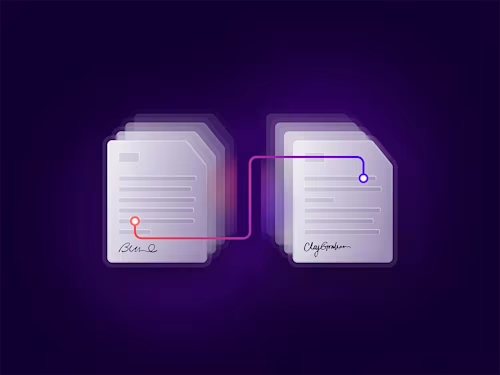
Beyond e-signatures: Unlocking the full potential of Docusign extension apps
Want to enhance your Docusign experience? Save time, reduce manual effort, and improve efficiency with Docusign extension apps.

In today’s fast-paced business environment, efficiency is paramount. Managing document workflows, tracking approvals, and ensuring timely signatures can be challenging without the right tools. Organizations across industries are increasingly relying on Docusign extension apps to streamline these processes, improve collaboration, and reduce administrative burdens.
Docusign extension apps enhance the capabilities of the Docusign platform by enabling seamless integrations, automating routine tasks, and optimizing document management workflows. These apps enable businesses to reduce manual efforts, minimize errors, and improve overall efficiency. Instead of users manually managing approvals, sending follow-ups, or transferring data between systems, extension apps handle these tasks automatically.
Understanding Docusign extension apps
Docusign for Developers provides a suite of powerful APIs and tools designed to enable developers to build scalable and efficient end-to-end agreement management solutions on the Docusign Intelligent Agreement Management (IAM) platform. By extending the core functionality of Docusign, extension apps help organizations optimize their document management systems. Whether it’s automating approvals, connecting with CRM platforms, or customizing document workflows, extension apps provide a powerful way to enhance how businesses manage agreements within Docusign.
To better understand how Docusign enables end-to-end agreement management, explore this developer blog, which provides insights into building seamless agreement workflows with Docusign’s developer tools.
Key benefits of Docusign extension apps
One of the primary reasons businesses adopt Docusign extension apps is to enhance efficiency and compliance while seamlessly integrating with existing software ecosystems. These apps automate routine administrative tasks such as sending signature reminders, routing documents for approval, and tracking progress, enabling employees to focus on more strategic work.
Integration is another major advantage. Many businesses rely on platforms such as Salesforce, Microsoft 365, and Google Drive for their daily operations. Docusign extension apps ensure that these platforms work together with Docusign efficiently, eliminating the need for repetitive data entry and manual document uploads. This streamlined approach helps maintain accuracy and reduces administrative overhead.
Customization is also a key factor, as every organization has unique requirements when it comes to document management. With Docusign extension apps, businesses can configure custom workflows, establish approval hierarchies, and automate notifications based on specific needs. This flexibility ensures that processes are structured efficiently without requiring costly, time-consuming development work.
Another crucial benefit is improved tracking and reporting capabilities. Monitoring document status, tracking approvals, and generating detailed reports are essential for maintaining transparency and ensuring compliance. Docusign extension apps provide real-time insights, enabling businesses to oversee their document workflows with precision and efficiency.
Practical applications of Docusign extension apps
Docusign extension apps are widely used across industries to improve productivity and enhance document processing. These apps help eliminate bottlenecks and inefficiencies, making agreement workflows more seamless and automated. A great example of this in action is Sandbox Banking’s Glyue app, which facilitates banking data integrations. Learn more about how fintech partnerships are leveraging Docusign extension apps in this article from The New Stack.
Below are some key ways organizations are using Docusign extension apps to enhance their operations:
Human resources: Automating onboarding processes by integrating Docusign with HR management platforms. Employment contracts, tax forms, and company policies can be signed electronically before an employee’s first day, reducing paperwork and ensuring a smooth onboarding experience.
Sales and contract management: Accelerating deal closures by connecting Docusign to CRM platforms such as Salesforce. When a client agrees to a proposal, the system automatically generates and sends contracts for signature, streamlining the entire sales process.
Legal and compliance: Ensuring regulatory compliance by structuring document approval workflows. Docusign extension apps help organizations maintain audit trails and adhere to industry regulations, minimizing the risk of non-compliance.
Real estate transactions: Simplifying the process of signing leases, agreements, and property transactions. Agents and clients can finalize documents remotely, eliminating delays caused by scheduling conflicts and paperwork errors.
These are just a few examples of how organizations leverage Docusign extension apps to reduce friction in their workflows. By incorporating these tools, businesses can create seamless, automated processes that boost efficiency and minimize errors.
Extension apps vs. API integrations
While both Docusign extension apps and API integrations enhance document workflows, they serve distinct purposes. API integrations are custom-built connections requiring development resources to link Docusign with other systems. They offer extensive customization options, but demand technical expertise and significant implementation time.
In contrast, Docusign extension apps function as prebuilt solutions for consumers, providing an easy way to enhance document workflows without extensive development. For the organizations that build these apps, they provide a way to integrate their own functionality into Docusign rather than embedding Docusign’s features into their own systems. This key distinction highlights how extension apps bring external capabilities into the Docusign platform, whereas API integrations embed Docusign’s features into external business environments. For organizations that need a tailored solution and have the technical resources to build it, API integrations may be the preferred choice. However, for those seeking a quick and efficient way to improve document workflows, extension apps offer a convenient and cost-effective alternative.
Building a Docusign extension app

While technical expertise is required to build an extension app, Docusign provides a structured approach to help developers build and deploy their apps successfully. Below is a high-level overview of the process:
Plan your extension app: Define your app’s purpose and identify the specific problem it solves, such as automating workflows, integrating with third-party platforms, or enhancing document tracking.
Set up your development environment: Create a Docusign developer account and obtain API credentials, including an integration key, which serves as the unique identifier for your app.
Use Docusign APIs and webhooks: Leverage Docusign APIs to interact with the platform and set up webhooks to receive real-time notifications about document status changes.
Implement authentication and security: Configure OAuth 2.0 for secure authentication, ensuring that users can access the extension app while maintaining data protection standards.
Develop and test in the demo environment: Build your app’s functionality, ensuring it meets business requirements. Use the Docusign demo (sandbox) environment to test its features before moving to production.
Register and deploy your app: Once the extension app is fully tested, register it with Docusign, configure its settings, and deploy it for internal use, private distribution, or public access in the Docusign App Center.
For a detailed step-by-step guide, visit the official Docusign developer documentation.
Private vs. public extension apps: Choosing the right distribution model
When deploying Docusign extension apps, organizations must decide between private and public distribution models. Private extension apps are custom-built solutions designed exclusively for use within a specific organization or among a select group of users. In contrast, public apps are listed in the Docusign App Center and available for general use.
Many businesses opt for private extension apps due to their enhanced security and data privacy. Since these apps are restricted to internal users, companies have greater control over data access, making them ideal for handling sensitive or proprietary information. Additionally, private apps enable businesses to create highly customized workflows and integrations tailored to their specific needs. Unlike public apps, which are developed for broad usability, private solutions ensure seamless integration with internal systems and business processes.
Compliance is another driving factor behind the choice of private apps. Industries such as finance and healthcare must adhere to strict regulatory requirements, and private extension apps enable organizations to structure document workflows in a way that ensures compliance without exposing sensitive data to external users. Furthermore, some companies develop proprietary document management processes that provide them with a competitive advantage. Keeping these workflows private prevents competitors from accessing or replicating them. For organizations prioritizing security, regulatory compliance, and tailored functionality, private extension apps offer a controlled and flexible solution that aligns with internal requirements.
Want to learn more about private extension apps? Stay tuned for an upcoming blog that dives into how businesses can build exclusive, tailor-made solutions within the Docusign ecosystem.
Accessing Docusign extension apps
Organizations interested in enhancing their document workflows can explore and install Docusign extension apps through the Docusign App Center. This platform provides access to a wide range of extensions designed to optimize document management, improve integrations, and enhance operational efficiency.

Unlocking the full potential of Docusign
In today's fast-paced environment, efficiency isn't just a luxury; it's a necessity. Docusign extension apps empower organizations to work smarter by automating tedious processes, integrating seamlessly with existing tools, and ensuring that document workflows run smoothly from start to finish. Whether you're streamlining HR paperwork, closing sales faster, or maintaining airtight compliance, these apps provide the flexibility and efficiency needed to stay ahead.
If you’re already using Docusign, now is the perfect time to explore how extension apps can enhance your workflow. Visit the Docusign App Center to discover solutions tailored to your needs. Don’t let manual processes slow you down. Take advantage of these powerful tools and start optimizing your document management today!
Dig deeper: Your guide to Docusign extension apps
Explore the full suite of Docusign APIs and developer tools at the Docusign Developer Center.
Get started with Extension Apps by exploring the Docusign Extension Apps 101 Guide.
Understand the key concepts behind building and using extension apps with this comprehensive overview.
Learn how to build your own extension app with the step-by-step developer guide.
Compare Extension Apps vs. API Integrations to determine the best approach for your project in this detailed breakdown.
Find and install extension apps that fit your needs in the Docusign App Center.

Niani Byrd joined the Docusign Developer Content team in 2024 as a Programmer Writer. With a background in software engineering and technical writing, she is passionate about helping developers discover and leverage the features of Docusign's APIs to build innovative solutions. Outside of work, she loves spending time with her dog, Niko.
Related posts

 DevelopersPublished Apr 16, 2025
DevelopersPublished Apr 16, 2025Introducing private extension apps
 DevelopersPublished Apr 16, 2025
DevelopersPublished Apr 16, 2025Seamlessly integrating Maestro with data systems using data IO extensions

Introducing private extension apps

Seamlessly integrating Maestro with data systems using data IO extensions
Discover what's new with Docusign IAM or start with eSignature for free



